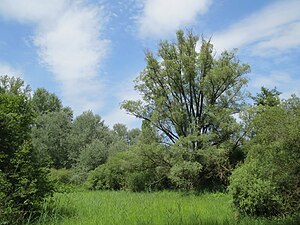Rhine lowlands from Philippsburg to Mannheim
|
FFH area
"Rhine lowlands from Philippsburg to Mannheim" |
||
|
Schwetzinger Wiesen-Riedwiesen nature reserve |
||
| location | City district of Mannheim , district of Karlsruhe and Rhein-Neckar district in Baden-Württemberg , Germany | |
| Identifier | DE-6716-341 | |
| WDPA ID | 555521680 | |
| Natura 2000 ID | DE6716341 | |
| FFH area | 36.374 km² | |
| Geographical location | 49 ° 20 ' N , 8 ° 31' E | |
|
|
||
| Setup date | January 1, 2005 | |
| administration | Karlsruhe Regional Council | |
The FFH area Rheinniederung from Philippsburg to Mannheim is a protected area (protected area identifier DE-6716-341) in the German state of Baden- which was registered in 2005 by the Karlsruhe regional council in accordance with Directive 92/43 / EEC (Fauna-Flora-Habitat Directive). Württemberg . With the ordinance of the regional council of Karlsruhe on the definition of areas of community importance of October 12, 2018, the protected area was established.
location
The approximately 3,637 hectares large FFH area is part of the natural environment 222- Northern Upper Rhine valley within the natural landscape main unit 22- Northern Upper Rhine lowlands . It lies between the Philippsburg district of Rheinsheim and the state border with Hesse along the Neckar and extends over the markings of nine cities and communities.
- City district Mannheim : 509.2344 ha = 14%
District of Karlsruhe:
- Oberhausen-Rheinhausen : 545.6083 ha = 15%
- Philippsburg : 472.8605 ha = 13%
Rhein-Neckar district:
- Altlußheim : 290.9911 ha = 8%
- Brühl : 363.7389 ha = 10%
- Hockenheim : 472.8605 ha = 13%
- Ketch : 618.3561 ha = 17%
- Schwetzingen : 290.9911 ha = 8%
- Edingen-Neckarhausen : 36.3738 ha = 1%
Description and purpose of protection
It is a floodplain landscape in the meandering zone of the Upper Rhine lowlands with pronounced high banks and recent flood dynamics. Hardwood and softwood alluvial forests and open land biotopes typical of the location, ravines and old Rhine systems, grassland complexes typical of floodplains, gravel and sand banks on the banks of the Rhine
Habitat classes
(general characteristics of the area) (percentage of total area)
Information according to the standard data sheet from the Official Journal of the European Union
| N06 - inland waters (standing and flowing) | 20% | |||
| N10 - Moist and mesophilic grassland | 23% | |||
| N14 - Meliorated grassland | 1 % | |||
| N15 - Other farmland | 5% | |||
| N16 - deciduous forest | 39% | |||
| N21 - non-forest areas with wooden plants (fruit and olive groves, vineyards) | 8th % | |||
| N23 - Other (including cities, villages, roads) | 4% | |||
Habitat types
According to Appendix 1 of the ordinance of the Karlsruhe Regional Council on the definition of areas of Community importance (FFH ordinance) of October 12, 2018, the following habitat types according to Annex I of the Habitats Directive occur in the area:
| EU code |
Habitat type (official name) | Short name | Hectares |
|---|---|---|---|
| 3140 | Oligo-to mesotrophic calcareous waters with benthic vegetation of chandelier algae | Lime-rich, nutrient-poor still waters with chandelier algae | 181.49 |
| 3150 | Natural eutrophic lakes with magnopotamion or hydrocharition vegetation | Natural nutrient-rich lakes | 353.50 |
| 3260 | Rivers of the planar to montane level with vegetation of the Ranunculion fluitantis and the Callitricho-Batrachion | Running waters with flooding aquatic vegetation | 35.90 |
| 3270 | Rivers with mud banks with vegetation of the Chenopodion rubri pp and the Bidention pp | Muddy river banks with pioneer vegetation | 2.50 |
| 6210 | Near-natural dry lime lawns and their stages of shrubbery (Festuco-Brometalia) | Lime grassland | 1.50 |
| 6410 | Pipe grass meadows on lime-rich soil, peaty and clayey-silty soils (Molinion caeruleae) | Pipe grass meadows | 9.80 |
| 6430 | Moist tall herbaceous vegetation of the planar and montane to alpine level | Moist tall herbaceous vegetation | 1.00 |
| 6440 | Cnidion dubii meadow meadows | Burning umbels | 0.50 |
| 6510 | Lean lowland hay meadows (Alopecurus pratensis, Sanguisorba officinalis) | Lean, lowland hay meadows | 103.50 |
| 9160 | Subatlantic or Central European Pedunculate Oak Forest or Hornbeam Forest (Carpinion betuli) | Chickweed-oak-hornbeam forest | 4.30 |
| 91E0 | Alluvial forests with Alnus glutinosa and Fraxinus excelsior (Alno-Padion, Alnion incanae, Salicion albae) | Alluvial forests with alder, ash, willow | 109.30 |
| 91F0 | Hardwood forests with Quercus robur, Ulmus laevis, Ulmus minor, Fraxinus excelsior or Fraxinus angustifolia (Ulmenion minoris) | Hardwood floodplain forests | 233.50 |
Contiguous protected areas
The FFH area consists of numerous sub-areas. It is partially congruent with several landscape protection areas and two bird protection areas. The nature reserves :
- 2012 - Rip Island
- 2013 - Ketscher Rheininsel
- 2064 - Wagbach lowland
- 2077 - Schwetzinger Wiesen-Riedwiesen
- 2078 - Oven-Riedwiesen
- 2110 - Head area on the Friesenheimer Altrhein
- 2128 - Hockenheimer Rheinbogen
- 2173 - Ballauf-Wilhelmswörth
are wholly or partially within the FFH area.
See also
Web links
- Data evaluation sheet and map in the profile of the FFH area in the protected area directory of the LUBW
- Profile of the Natura 2000 area 6617-341 Rhine lowland from Philippsburg to Mannheim (FFH area) at the Federal Agency for Nature Conservation

